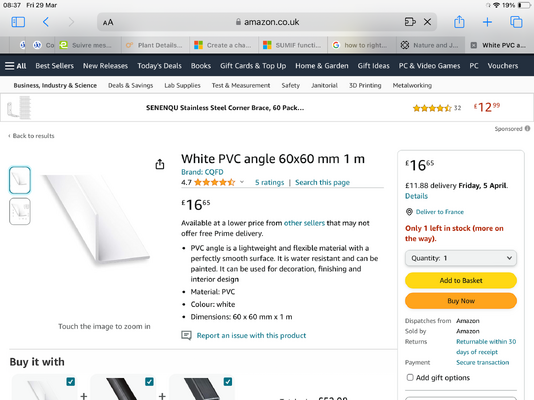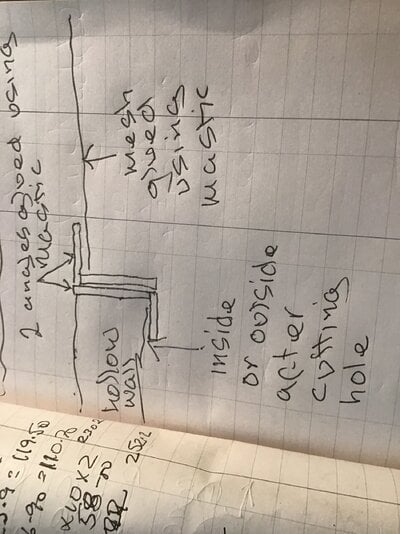Moon Daizy
Chirping
- Mar 28, 2024
- 31
- 177
- 76
Hello everyone 
I would love to hear the opinions and advice of seasoned chicken keepers please! (I have searched this site far and wide for information that I'm looking for, but have not found it all exactly, hence the post).
Basic info: Location, Chicken numbers/breeds etc
We are looking to get apx 4 - 6 large chicken breeds, like Orpington, Plymouth barred rock, Colombian Blacktail hybrids or similar this year, and are desperately trying to get everything ready so we are ready when the girls are - but trying not to rush things at the same time! We live in south U.K.; so fairly mild and wet.
Coop Plans So Far
For various reasons, I have opted for a plastic shed for our coop, rather than a wooden coop or a wooden shed. I am hoping this turns out to be a good decision! Red mites were a consideration, as was ease of cleaning out, and maintenance. And costs of buying a stand-alone coop didn't appeal, especially as I would need storage space for their food, DE etc, AND a coop AND a whole section of fence and other things to make the run. Costs just add up
The shed is yet to be delivered so the pictures are from the manufacturer's website. It will be delivered next week..! Eggciting!
I have ordered an omlet automatic door, which we will attach to the side and my hubby is going to work his cleverness by switching out the batteries for a solar panel... but more importantly...
but more importantly...
Think that's everything.... for now!!
Looking forward to receiving your (constructive) feedback. Thanks in advance

I would love to hear the opinions and advice of seasoned chicken keepers please! (I have searched this site far and wide for information that I'm looking for, but have not found it all exactly, hence the post).
Basic info: Location, Chicken numbers/breeds etc
We are looking to get apx 4 - 6 large chicken breeds, like Orpington, Plymouth barred rock, Colombian Blacktail hybrids or similar this year, and are desperately trying to get everything ready so we are ready when the girls are - but trying not to rush things at the same time! We live in south U.K.; so fairly mild and wet.
Coop Plans So Far
For various reasons, I have opted for a plastic shed for our coop, rather than a wooden coop or a wooden shed. I am hoping this turns out to be a good decision! Red mites were a consideration, as was ease of cleaning out, and maintenance. And costs of buying a stand-alone coop didn't appeal, especially as I would need storage space for their food, DE etc, AND a coop AND a whole section of fence and other things to make the run. Costs just add up

The shed is yet to be delivered so the pictures are from the manufacturer's website. It will be delivered next week..! Eggciting!
I have ordered an omlet automatic door, which we will attach to the side and my hubby is going to work his cleverness by switching out the batteries for a solar panel...
 but more importantly...
but more importantly...- Ventilation....:
I have ordered 2x tumble drier style vents to attach at the back of the shed near the roof line. It already has two vents at either end of the shed. I will cover all the vents with insect cloth. The window of the shed I intend to do something with - fully removable for the summer (I will attach hardwire over the gap for sure), but I might make it so I can pop it back in there for winter. I am conscious that the black colour of the shed will make it hotter in the sun - good in the winter, bad in the summer, so I know the ventilation will need to be flexible and adequate.
I was intending on having the back of the shed, with the tumble drier vents facing the prevailing wind so no driving rain can get into the coop, but fresh air should still make it in there. The back of the shed will be up against a feather-board fence so will be partly sheltered anyway.
Ventilation Q1: Does it matter about prevailing winds? Like, does the way you position your coop and/or the vents matter, does the prevailing wind direction have any bearing on these things?
Ventilation Q2: Do you think this will be adequate ventilation? Or is it the case that more is more, when it comes to chickens? If more - what advice can you give? How would you experienced chicken keepers do it?
- Lighting...:
That window is tiny, and will likely be facing North. I think I need to add more windows.... Has anyone any experience of how you would do this for a resin shed? If I cut pieces out of the plastic, I am not sure what I could attach to it in terms of windows. Maybe perspex?
- Coop internal design...:
I intend to separate the shed coop into thirds: two thirds for the girls, and one third for storage. I'm trying to work out how I can get a brooder in the storage part, so the girls can see any broody hens/chicks through the wire. I will start doing some scale drawing plans soon.
We are going to include poop boards with a lip, caulked etc so no grime gets in the cracks. Thanks for 'Dobie lover' for her amazing article and coop build for the inspiration there. I will build all-same-level roosting bars over the poop boards. I do not intend to have any food or water in the coop, to avoid extra humidity in there, and to encourage the girls to go outside. They will have a fully predator proof run, with composting area, as part of their regularly accessible run area.
I intend to do deep litter method in there.
I have not worked out how the nest boxes will be. I home educate my two children, and this will be an assignment they will be involved in after Easter - I really want them to feel included, as so far the fence and run and groundworks have not been child labour suitable


Internal design Q1: If anyone has any advice on how to include all of these things (poop boards, same level perches, nest boxes, brooder area, storage) into a small space I would really appreciate the inspiration!!
Think that's everything.... for now!!
Looking forward to receiving your (constructive) feedback. Thanks in advance

Last edited:





